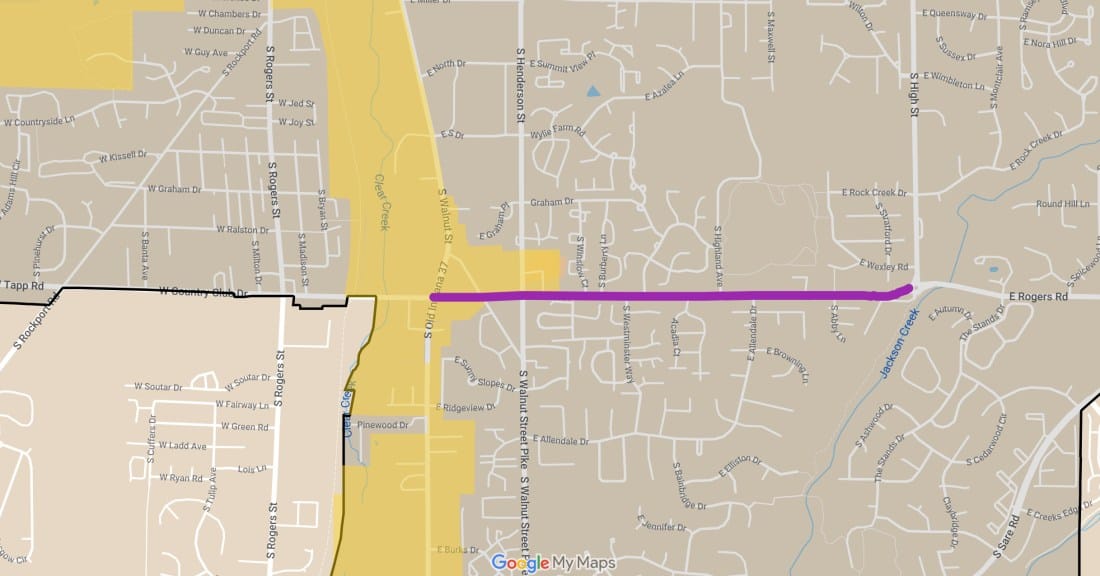Winslow Road resurfacing gets some discussion by Bloomington RDC, but no vote on contract


An item related to a Winslow Road resurfacing project—which was postponed by Bloomington’s redevelopment commission from its meeting two weeks ago—still did not get a vote by the RDC on Monday.
The resolution that appeared Monday’s meeting agenda did not need a vote, according to assistant city attorney Larry Allen, because the construction contracts were not yet ready to be approved. And the contract approvals were not yet ready because the grant from INDOT’s Community Crossings matching grant program has not yet been awarded.
But public works director Adam Wason was able to respond to questions from RDC members about the project. The item had been postponed from two weeks ago, because Wason was not able to attend that meeting.
On Monday, Allen also sketched out the legal department’s position on why TIF (tax increment finance) funds are allowed to be spent on a project like Winslow Road resurfacing. The project entails milling down the surface of the road by a couple of inches, laying new asphalt and re-striping the pavement.
Winslow Road cuts east-west across the southern part of Bloomington.
In early September, the RDC had already voted to handle the Winslow Road resurfacing work as a $500,000 TIF project. Since then, the scope of the project has been reduced. Instead of extending from South Walnut Street to High Street, it will extend just to Allendale Drive.
The preliminary engineering work for the project is hoped to start this fall. Construction is supposed to be done by the end of 2023.
At Monday’s meeting, Wason described how Bloomington has applied for a 50-50 matching grant through INDOT’s Community Crossing grant program to help pay for the Winslow Road project. Past Community Crossing projects for Bloomington included resurfacing for College Mall Road, Smith Road on the east side, and Kirkwood Avenue downtown, Wason said.
Normally, the city pays for projects like road resurfacing with money from the motor vehicle highway fund. But the COVID-19 pandemic had an impact on revenue to the fund, because it depressed traffic volumes, which reduced fuel consumption, which reduced revenue from the fuel taxes that feed into the fund.
Revenue to Bloomington’s motor vehicle highway fund dropped from $1,730,360 in 2019 to $1,385,364 in 2020.
The request of the RDC to use TIF funds to match the Community Crossings grant was due to what Wason described as the “unique circumstances” of the last few years, as the COVID pandemic impacted revenue to the motor vehicle highway fund.
Responding to a question from RDC member Sarah Bauerle Danzman, Wason said Winslow Road was identified for the resurfacing work, based on the city’s asset management system, which includes an inventory of road and sidewalk conditions made with a LIDAR scan.
Responding to a question from RDC member Deborah Myerson, who pointed to some gaps in the pedestrian infrastructure east of Allendale Drive among other places, Wason said the Winslow Road would not include any additional pedestrian enhancements. That’s because such improvements are not eligible for Community Crossing grant funds.
Assistant attorney Larry Allen responded to a question from The B Square about the legal justification for using TIF funds—for a project that seems more like maintenance of existing infrastructure as opposed to the construction of a new public improvement.
Allen said that because the existing pavement would be milled down and the road would be completely resurfaced, integrating it with the current improvements, including required upgrades to ADA ramps, the city sees it “as a public improvement as opposed to just merely maintenance.”




Comments ()